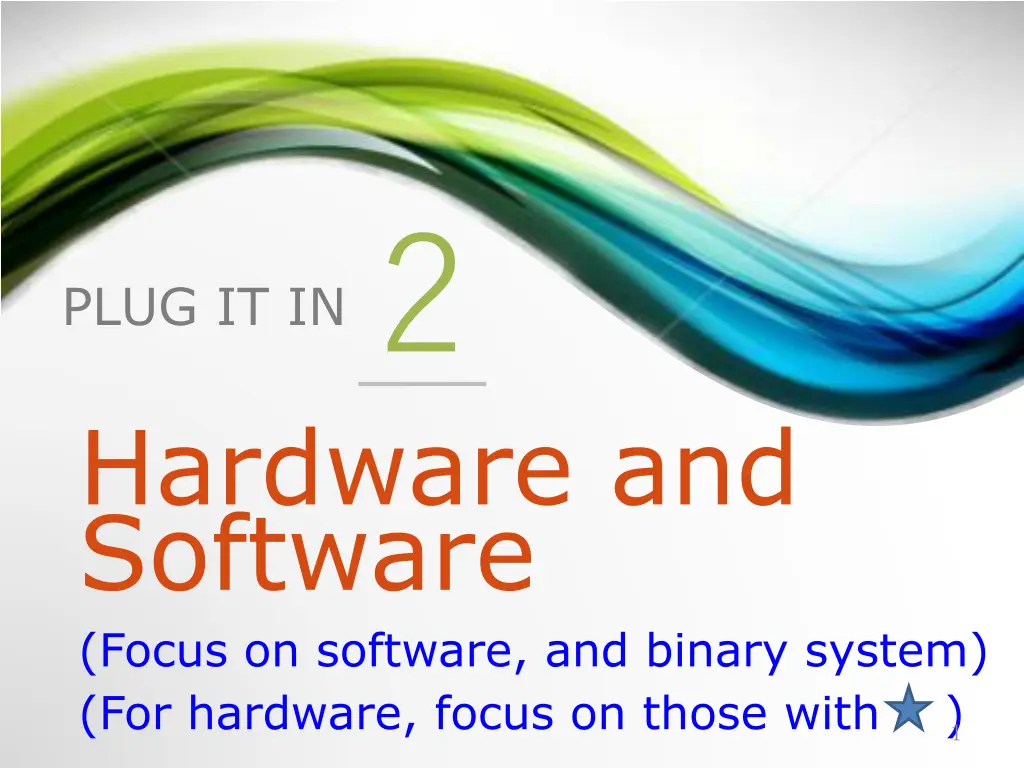
Understanding Hardware and Software: A Comprehensive Overview
Delve into the realm of hardware and software to grasp their significance in the digital landscape. Uncover strategic issues tying hardware design to business strategies, differentiate key software types, and explore the evolution of hardware technologies. From CPUs to storage systems, discover the essentials and analyze the impact of advancements on productivity. Contemplate the implications of portable devices on work styles and the challenges posed by the BYOD trend. Gain insights into computer hierarchy and the diverse categories of computing systems, from supercomputers to microcomputers.
Download Presentation

Please find below an Image/Link to download the presentation.
The content on the website is provided AS IS for your information and personal use only. It may not be sold, licensed, or shared on other websites without obtaining consent from the author. If you encounter any issues during the download, it is possible that the publisher has removed the file from their server.
You are allowed to download the files provided on this website for personal or commercial use, subject to the condition that they are used lawfully. All files are the property of their respective owners.
The content on the website is provided AS IS for your information and personal use only. It may not be sold, licensed, or shared on other websites without obtaining consent from the author.
E N D
Presentation Transcript
PLUG IT IN2 Hardware and Software (Focus on software, and binary system) (For hardware, focus on those with )1
1. Introduction to Hardware 2. Introduction to Software 2
>>> 1. Discuss strategic issues that link hardware design to business strategy. 2. Differentiate between the two major types of software. 3
PI2.1 Introduction to Hardware Hardware Strategic Hardware Issues Computer Hierarchy Input and Output Technologies The Central Processing Unit (CPU) Computer Memory 4
Hardware Hardware Consists of: Central Processing Unit (CPU) Primary Storage Secondary Storage Input Technologies Output Technologies Communication Technologies 5
Strategic Hardware Issues How do organizations keep up with the rapid price reductions and performance advancements in hardware? How often should an organization upgrade its computers and storage systems? Will upgrades increase personal and organizational productivity? How can you measure productivity increases? 6
Strategic Hardware Issues Portable computers and advanced communications technologies have enabled employees to work from home or from anywhere. Will these new work styles benefit employees and the organization? How do organizations manage such new work styles? 7
Strategic Hardware Issues (continued) How do organizations manage employees who use their own portable devices (e.g., tablets and smartphones) for both personal and work purposes? That is, how do organizations handle the bring-your-own-device (BYOD) phenomenon? 8
Computer Hierarchy Supercomputers Mainframe Computers Midrange Computers Microcomputers Desktop PC Laptop and Notebook Computers Thin-client systems Categorization from: Categorization from: - Application scenario Application scenario - Computing power Computing power (changing) (changing) - Price (changing) Price (changing) - Size (changing) Size (changing) 9
Computer Hierarchy (continued) Netbooks Tablet Computers Wearable Computers 10
PURCHASING A COMPUTER 11
Input Technologies (453-455) Graphics tablet Joystick Touchscreen Stylus Digital Pen Web Camera (Webcam) Voice Recognition Gesture-based Input Wii Microsoft Connect Leap Motion Controller Automated Teller Machine (ATM) Magnetic Strip Reader Point-of-sale Terminals Barcode scanners Most common in business POS 12
Input Technologies (continued) Optical Mark Reader Magnetic Ink Character Reader Optical Character Reader Sensors Cameras Radio-Frequency Identification (RFID) Internet of ______ 13
Output Technologies (455) Monitors Cathode Ray Tubes (CRT) Liquid Crystal Displays (LCDs) Flexible Displays Organic Light-emitting Diodes (OLED) Retinal Scanning Displays Heads-up Displays Printers (laser, Inkjet, Thermal) Plotters Voice Output Electronic Book Reader Pocket Projector 14
Central Processing Unit How the CPU works Central processing unit (CPU) - The actual hardware that interprets and executes the program (software) instructions and coordinates all the other hardware devices Arithmetic-logic unit (ALU) -Performs all arithmetic operations (ex: + and -) and all logic operations (ex: sorting and comparing numbers) Control unit -Interprets software instructions and tells the other hardware devices what to do, based on the software instructions Advances in Microprocessor Design Moore s Law Mega Hertz (MHz); Giga Hertz (GHz) 15
Computer Memory Memory Capacity Byte, KB, MB, GB, TB, PB Binary system: two digits 0, 1 Primary Storage (or Main Memory) Secondary Storage Need to be able to understand a binary number: next three slides Plus: Dr. Zhang s handout Information Technology Handout 1: Binary Number System , posted on class web 19
Bits and Bytes (Zhang) 1. 1 bit has only 2 states, that can be used to represent 0 and 1 2. 2 bits have 22 = 4 states: 00, 01, 10, 11, that can be used to represent 0, 1, 2, 3 Binary System Place value 22 21 20 One bit 0 Decimal System 2 Decimal value 4 1 0 1 bit 0 1 1 1 0 0 2 bits 0 0 0 Two bits 0 1 0 1 1 1 0 1 0 2 1 1 1 1 3
Bits and Bytes (Zhang) 3. 3 bits have 23 =__ states: __________, that can be used to represent __________ Place value Decimal value 0 22 21 20 4 2 1 0 0 0 0 0 0 0 0 0 1 0 1 1 0 1 0 1 0 0 0 0 1 0 1 1 0 1 0 1 0 1 2 3 4 1 1 1 0 1 1 1 0 1 1 1 1 0 1 1 1 0 1 5 6 7
Bits and Bytes (cont) 1. Converting binary to decimal: Binary 1 0 1 1 = Watch colors 1x23 + 0x22 + 1x21 + 1x20 = 1. Converting decimal to binary: Decimal 23 = 1x16 + 0x8 + 1x4 + 1x2 + 1x1 = Binary ________________ 2. Binary numbers in use: numeric web address - IP See IT Handout 1 for details
Computer Memory Primary Storage (or Main Memory) (Next slide) Secondary Storage (next two slides) Solid-state drives (SSD) (P. 459) 23
Computer Memory cost, speed, capacity / Speed 24
PI2.2 Introduction to Software Software Software Issues System Software Application Software 26
Software Programming Programmers Two Types of Software: Systems Software Application Software 27
Software 28
Systems Software Systems Software Operating System Windows, MacOS Android, iOS OS functions: SAM, com Human-Computer Interface Graphical User Interface (GUI) Social Interface Motion Control Gaming Consoles 29
Application Software Personal Application Software Office, email, browser Enterprise Application Software ORACLE, SAP Workflow software http://www.capterra.com/workflow- management-software/ In-between: FreshBooks, Sage, QuickBooks TurboCAD, DesignCAD SAS, SPSS https://en.wikipedia.org/wiki/Application _software#Classification 30
Software Issues Software Defects SEI s definition of good software (P. 461) Ultra-Large Scale Systems (ULS Systems) Software Licensing Open Systems Interoperability; portability Proprietary Software, vs Open-Source Software 31
Trends in Software not in the book but should know a bit SaaS: Software as a service PaaS: Platform as a service IaaS: Infrastructure as a service https://apprenda.com/library/paas/iaas-paas- saas-explained-compared/ https://support.rackspace.com/white- paper/understanding-the-cloud-computing-stack- saas-paas-iaas/ https://www.computenext.com/blog/when-to- use-saas-paas-and-iaas/ 32






















